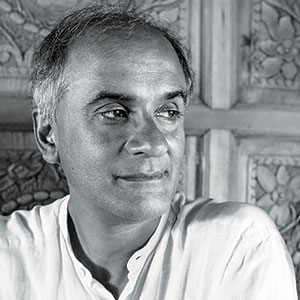Arts
Pico Iyer Meditates on
Death and Dying
 TURN, TURN: As he enters the autumn of his own life, travel writer Pico Iyer revisits Japan. Brigitte Lacombe
TURN, TURN: As he enters the autumn of his own life, travel writer Pico Iyer revisits Japan. Brigitte Lacombe
Only Pico Iyer would compare crumbling maple leaves to the deteriorating health of his elder Japanese in-laws. In Japan, as he notes in his new book, Autumn Light: Season of Fire and Farewells, distinctions between sadness and beauty are not so clear as they are in the West.
An American travel writer born in Britain to Indian parents and educated at Oxford, Iyer has spent decades embroidering the threads of his own Western and Eastern identities. This time around, his meditative new book is both an ode to the season of autumn and a gloriously plotless contemplation on the impermanence of life.
While traveling on assignment, Iyer learns about the passing of his wife Hiroko's 91-year-old father. After Iyer returns home, death penetrates everything. Hiroko's widowed mother then grows senile, sometimes unable to remember that her husband of 60 years is actually dead. And then there's the ever-growing estrangement of Hiroko's brother, a Jungian analyst who lives nearby but has long since disowned his family. The rest of the narrative explores how the Japanese deal with death, loss, emotional distance and the relativity of sadness, all through the lens of autumn, with interludes from Thoreau, Basho and Leonard Cohen.
"Autumn is the season of subtractions, the Japanese art of taking more and more away to charge the few things that remain," Iyer writes. "At least four times as many classical poems are set in autumn and spring, the seasons of transition, than in summer and winter."
The book reads like one of those classic poems, yet with a Zen-style emphasis on the unfolding background of everyday life. Iyer even writes that when East Asian students are shown a painting, they notice the background as surely as Westerners tend to see the figures in the foreground.
As such, Autumn Light is almost all background, all middle, without a real beginning or end. There is no plot in the Western sense, nothing that goes from point A to point B in linear fashion. Instead we get the ins and outs of Iyer's daily routines in the cookie-cutter Nara suburb of Deer's Slope, "a bright rectilinear neighborhood of vending machines and hair salons." We learn about his evening trips to the health club to play ping-pong with his senior friends, each one of which seems to have a different method for dealing with his or her own autumn years. We get his trips to the post office, his journeys up the mountain, or his regular household existence with Hiroko, whose life of seasonal procedures, superstitions and simplicities forms a wonderful counterpart to Iyer's complex inner-voyaging. Even after a quarter century of sharing a tiny flat, she has little sense of the details involved with what he does for a living and he claims little knowledge of the minutiae of her retail job.
Autumn reigns supreme throughout the story. Even as Iyer travels for good portions of the year, every year, he always returns to Japan for autumn. What he loves most about Nara, in particular, is its neglectedness, he says. The city carries "a slightly forlorn quality, making it almost a monument to autumn."
Iyer's published his first book on Japan in 1991. The Lady and the Monk documented the first year he spent in Kyoto, when he first met Hiroko. Intermittent reverberations from that book emerge in Autumn Light, woven into the current-day story, amplifying how Japan has taught Iyer to deal with aging, time, grief and loss in ways that are lost on the average Westerner.
But Autumn Light is not a "part two" of the first book. Iyer now looks back with a half-lifetime of wisdom to reflect on what he's learned over his half-Japanese existence.
This "is not a sequel to the book I wrote on Japan 28 years ago, except insofar as autumn is a sequel—a prequel—to spring, the companion piece that rounds the picture out," he writes.
Toward the end, Hiroko is trying to read a draft of the autumn book that Iyer is working on. As he tries to explain it, she asks if it's like a Yasujiro Ozu film, a "little no-action movie." Perhaps she knows Iyer more than he realizes.
Autumn Light: Season of Fire and Farewells
Pico Iyer
Knopf


